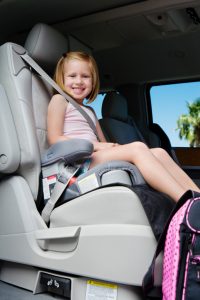According to the Oklahoma State Department of Health, improper car seat use leaves four out of five children inadequately restrained and vulnerable to injury during transport.
When car seats and boosters are installed correctly and properly fitted to a child, infants under age 1 are 71 percent less likely to die in a car crash. Toddler-age fatalities are reduced by 51 percent when the children are properly secured in car seats.

Child restraint use isn’t optional in Oklahoma, and there are several laws outlining the appropriate restraint system for all child passengers. In addition to understanding child seat safety laws, Oklahoma parents and guardians should know that adult seat belt use is an easy way to ensure children grow up practicing standard vehicle safety like buckling up.
According to the Centers for Disease Control and Prevention (CDC), restraint use among young children can depend upon the driver’s seat belt use; almost 40 percent of children riding with unbelted adult drivers were themselves unrestrained, reports the CDC. In 2015, Oklahoma’s seat belt use rate was 85.4 percent, which was less than the national average of 88.5 percent.
Oklahoma Child Car Seat Laws
Oklahoma child car seat laws were established to ensure our smallest passengers are protected in the event of a crash. The age, weight, and height of a child determine what kind of seat is required and where and how such restraints must be located and installed.
Here’s a breakdown of Oklahoma’s child car seat laws:
- Infants and all children less than 2 years old must ride in a rear-facing car seat. Car seats should be installed in the back seat of the vehicle and fitted according to the manufacturer’s instructions.
- All children less than 4 years old must be restrained in a child safety seat with an internal harness. These forward-facing seats should be used as long as possible or until the child reaches the upper limits of the seat’s weight recommendations.
- Children between 4 and 8 are required to sit in a fitted car seat or booster until they reach a minimum of 4 feet, 9 inches tall.
- Children 8 years and older may ride without a restraint system, but they must wear a seat belt.
While not explicitly stated by law, it’s recommended that all children under age 13 ride in the back seat of a car.
How to Pick the Right Restraint System
Front seat airbags eject with incredible force upon collision. Some car safety features like airbags are not specifically designed for small front seat passengers and could hurt a child who’s not properly fitted for a car seat or who is riding in the front seat before it’s safe.

Rear-facing seats, for example, ensure infants and small babies are less likely to suffer an injury from car safety features, but only if they’re used properly.
Parents who aren’t familiar with baby car seats and boosters should get to know the following three types, which offer distinct features:
- Infant Car Seat (rear-facing only): Infant car seats are expertly designed for newborns and babies. These small, portable car seats can only be used rear-facing. Infants outgrow these car seats quickly, but all infants and children less than 2 years old must remain in rear-facing seats—it’s the law.
- Convertible Seat: These dynamic seats give your baby plenty of room to grow. These seats make it easy to transform a rear-facing seat to a forward-facing one complete with harness.
- All-In-One Seat: The all-in-one seat can do everything a convertible seat can do, but it can also change into a booster seat as a child gets older. The added booster seat gives parents everything they’ll need to ensure their children are safety compliant to age 8.
In addition to the type of car seat, here are a few other things to consider:
- Newer cars have more safety features than older models; vehicles without a rear seat are less safe for infants and other young children.
- Always read and understand the weight and height maximums noted by the seat or booster manufacturer. These guidelines ensure a proper fit and secure restraint.
- Always check the expiration date on previously used car seats or boosters; never use a car seat or booster that has been involved in a crash.
- Try several different car seats before making a purchase. Depending on the car and a family’s lifestyle, certain car seat types may be easier to install than others.
- Parents: Always remember to buckle up! Children observe this behavior and mirror what they see.
Oklahoma Car Seat Programs
In an effort to aid parents, the Oklahoma Highway Safety office has dozens of inspection stations across the state to ensure parents are using the right restraint systems and installing them properly.
Oklahoma has also taken steps to ensure that car seats are available to parents of limited means. WIC recipients (Women, Infants and Children program) and SoonerCare members are eligible to receive a free car seat or booster and instillation assistance. Schedule an appointment at a nearby inspection station to learn more.
Motor vehicle accidents remain a major cause of death for children 14 and under in Oklahoma. However, child fatalities can be reduced significantly if we take steps to ensure every child is properly secured.
If you or your child was injured by a negligent driver, or if a child car seat was defective in protecting your young passenger, the experienced attorneys at Carr & Carr want to hear your story.
Call 866-510-0580 today to schedule your free consultation or tell us what happened online to get started now!





